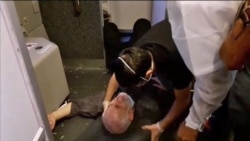Controversy surrounding reports of an Iranian airliner being intercepted by U.S. fighter jets over Syria on Thursday, 23 July continued on Friday with many questions raised that have yet to be answered.
Some of the questions asked include: Have the Iranians tried to provoke U.S. forces by flying over their base in Tanf at the border with Jordan?
If the Mahan Airline plane headed to Damascus or Beirut was on a routine flight from Tehran why did U.S. forces choose to intercept it? Certainly, Mahan airlines must be conducting other flights, at least to Syria. Why did U.S. forces feel the need to make a visual identification of this particular flight?
Having regard to Mahan Air's background and its links to the Revolutionary Guard, did U.S. forces have possible information that a military or a Hezbollah figure was on board the plane?
Did they suspect the passenger aircraft was carrying weapons and ammunition, as Mahan Air has a track record of doing that?
Hasn't the Beirut airport been closed for some time? Why and how did the aircraft land in that airport?
Why Syria's flight control did not direct the aircraft to land in Damascus where it was possibly supposed to land in the first place? Although there were initial reports by Iranian sources that the plane first landed in Damascus, there has been no official statement about its initial destination or a landing in Damascus.
The pilot of the airliner told Iranian media that he got so scared he suddenly reduced altitude and some passengers were injured. Iranian journalists said to be on board immediately produced films of injured passengers.
An Iranian activist in the Netherlands, Ammar Maleki said in a tweet that the plane was probably carrying weapons or terrorists on board and that is why the pilot panicked as soon as he saw the U.S. jets and maneuvered to land at once.
Why there were Iranian State TV reporters on board, ready to report the incident? Wasn't this a pre-planned provocation to overshadow the case of the downing of a Ukrainian airliner by the IRGC? The case of the Ukraine airliner is once again in media spotlight as its flight voice recorder was read and handed over to Iran which is still silent about the matter while Ukraine's officials say they have access to evidence that proves "interference" with the flight.
On the other side of the story, the U.S. military says it was a routine inspection carried out within a safe distance according to international standards: “The visual inspection occurred to ensure the safety of coalition personnel at Tanf garrison,” U.S. Central Command spokesman Bill Urban said. “Once the F-15 pilot identified the aircraft as a Mahan Air passenger plane, the F-15 safely opened distance from the aircraft.”
Foreign Policy Analyst Jason Brodsky, who is Policy Director at the United Against Nuclear Iran, highlighted the controversy and conflicting remarks about the cause of the incident in a tweet saying that "Iran says US jet came within 100 meters of the Mahan Air flight, whereas US is saying its jets flew within roughly, 1,000 meters," adding that according to Mehr news agency, Iran is waiting for radar transmission data to come in from Syria.
During the past year, Israel and the United States have accused Mahan Air of shipping weapons and fighters to the Lebanese militant group Hezbollah and Iran-linked groups in Syria and the region. The United States imposed sanctions on Mahan Air in 2011. But it is not only accusations. In interviews with Iran's state-owned television and IRGC-linked media outlets, Mahan Air pilots at different times have spoken about how they breached passenger airliners' safety standards during flights to Syria and Yemen.
On a recent occasion, a Mahan Air pilot told an IRGC-linked website in Tehran that he once carried seven tons of "prohibited cargo" to Syria in 2013 with former Qods Force Commander Qassem Soleimani also on board. Amir Assadollahi, the Mahan Air pilot, says he carried the prohibited cargo, most probably weapons and ammunitions on board a passenger aircraft with some 200 people onboard. He added that the pilots hid Soleimani in the cockpit during inspections in Iraq as he was dressed as a flight engineer.
On Friday, Iran lodged a complaint with the Civil Aviation Organization about the case. Iran's UN envoy Takht Ravanchi said the previous day that he would file a complaint with the UN later.
In the meantime, some Iranian officials tweeted threats against foreign leaders. Presidential adviser Hesamoddin Ashna tweeted: "If you like your leaders' you wouldn't play with the lives of our passengers!"
An Iranian twitter user wrote that this is a death threat against Trump or Netanyahu.
Iranian lawmaker Ardeshir Motahhari also threatened that "those who threaten Iranian airliners should wait for Iran's hard revenge where and when we decide."
On the other hand, another Iranian twitter user, posted a map of U.S. bases surrounding Iran and asked: "Where could our airliners fly to avoid U.S. bases?"






